Papilio glaucus
The Eastern Tiger Swallowtail, scientifically known as Papilio glaucus, is a stunning and easily recognizable butterfly known for its distinct beauty and impressive size.
The Eastern Tiger Swallowtail, a majestic butterfly, predominantly inhabits the Eastern United States. Its range extends from New England down to the Gulf Coast and as far west as the Great Plains.
These butterflies are versatile in their habitat preferences, thriving in diverse environments. They are commonly spotted in deciduous woodlands, lush forests, riversides, and swamps. These areas provide their preferred host plants, like wild black cherry and tulip trees.
Additionally, Eastern Tiger Swallowtails are frequent visitors to suburban gardens and parks drawn by flowerbeds and blooming shrubs. Their adaptability to different habitats makes them a familiar and beloved sight in their geographical range.
The Eastern Tiger Swallowtail butterfly is the state butterfly of Alabama, Delaware, Georgia, and South Carolina.
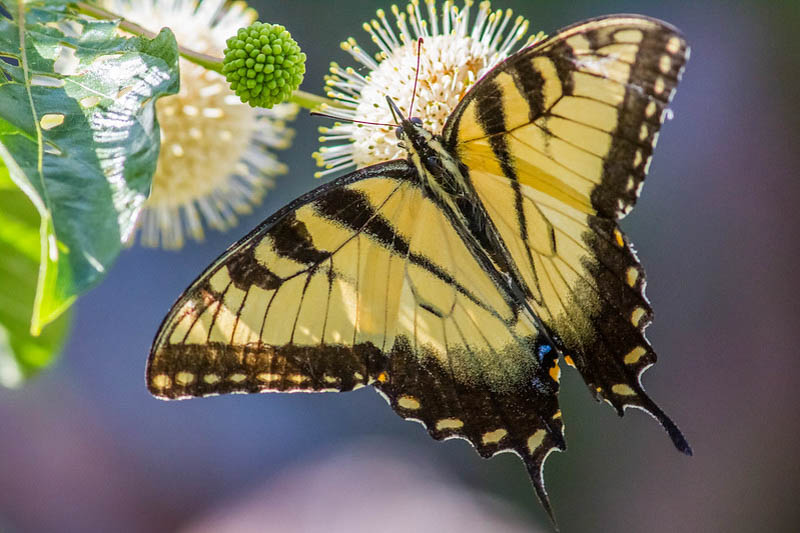
The Eastern Tiger Swallowtail butterfly boasts a distinctive and captivating appearance. Their physical appearance varies between males and females:
The butterfly’s wingspan ranges between 3 and 5.5 inches (8 to 14 cm), making it one of the larger North American species. Its characteristic long tail extensions, resembling a swallow, add to its elegant and dramatic presence.
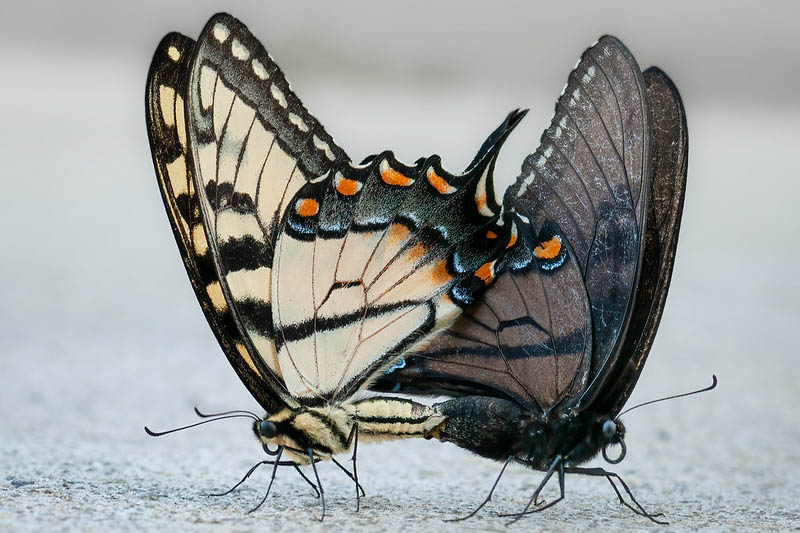
The courtship and mating rituals of the Eastern Tiger Swallowtail are fascinating displays of butterfly behavior. These rituals are key to the continuation of the species and are characterized by distinct aerial dances and pheromone exchanges.
Aerial Courtship: The courtship usually begins with the male Eastern Tiger Swallowtail performing a unique flight pattern to attract a female. He flies in loops and dives, showing off his vibrant colors and agility. This display is a visual spectacle and a demonstration of the male’s fitness and suitability as a mate.
Pheromone Communication: Males release pheromones to entice females. These chemical signals are essential to butterfly communication, informing the female of the male’s presence and readiness to mate.
Female Response: If a female is receptive to the male’s advances, she will allow him to approach. This acceptance is usually indicated by a decrease in her flight activity, signaling her willingness to mate.
Mating: Once the courtship is successful, the pair will mate. During this time, they often rest on leaves or other surfaces, connected end to end. The mating process can last several hours, during which the male transfers his spermatophore to the female, providing her with the sperm needed for fertilization and nutrients to aid in egg development.
Post-Mating: After mating, the female lays her fertilized eggs on suitable host plants, ensuring the next generation of Eastern Tiger Swallowtails.
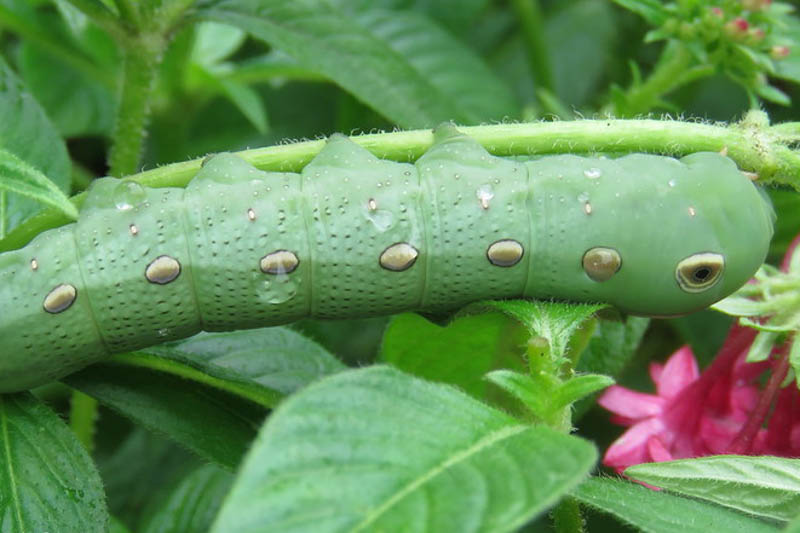
The life cycle of the Eastern Tiger Swallowtail is a remarkable transformation journey, encompassing four distinct stages: egg, caterpillar (larva), chrysalis (pupa), and adult butterfly. Each stage is unique and vital to the species’ lifecycle.
Egg Stage: The life cycle begins when a female lays eggs, usually on the underside of host plant leaves. These eggs are small, spherical, yellowish green with reddish dots, typically laid on wild black cherry, tulip tree, ash, or willow.
Caterpillar Stage: After about a week, the eggs hatch into caterpillars. Early instars of the caterpillar are brown and white; they resemble bird droppings, providing camouflage against predators. As the caterpillar grows, it changes color and pattern, becoming green with blue and yellow eyespots on its thorax, resembling a snake to deter predators. The caterpillar feeds voraciously on the host plant leaves during this stage, growing rapidly.
Chrysalis Stage: After fully growing, the caterpillar forms a chrysalis, undergoing metamorphosis. The chrysalis ranges from off-white to dark brown, blending with the surrounding environment. Within the chrysalis, the caterpillar’s body transforms, a process that takes about two weeks.
Adult Butterfly Stage: The final stage is the emergence of the adult butterfly. The newly emerged butterfly will rest and pump hemolymph into its wings to expand and harden them. Once its wings are ready, the Eastern Tiger Swallowtail begins its life as a pollinator, feeding on nectar from a variety of flowers.
The entire cycle, from egg to adult, typically spans about a month, with the species producing multiple generations each year, especially in the warmer southern parts of its range. This fascinating cycle of transformation showcases nature’s wonder and underscores the importance of each life stage in the species’ survival.
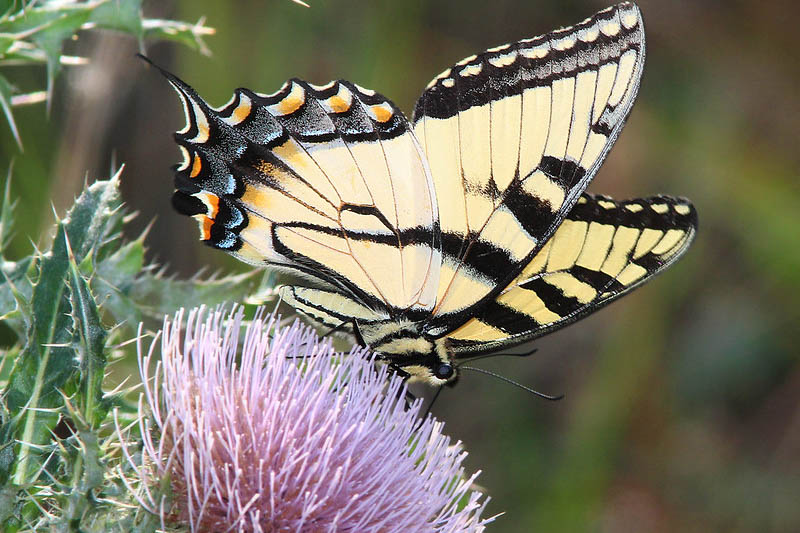
The diet of the Eastern Tiger Swallowtail varies significantly between the caterpillar and adult stages of its lifecycle:
Caterpillar Diet: The caterpillars of the Eastern Tiger Swallowtail are herbivorous and feed primarily on the leaves of a variety of host plants. Favorite host plants include trees such as wild black cherry (Prunus serotina), tulip tree (Liriodendron tulipifera), sweet bay (Magnolia virginiana), ash (Fraxinus spp.), lilac (Syringa vulgaris), hop tree (Ptelea trifoliata), cottonwood (Populus spp.), and willow (Salix spp.).
These caterpillars are known for their voracious appetite, which is crucial for accumulating energy for their transformation into butterflies.
Adult Butterfly Diet: Adult Eastern Tiger Swallowtails, like most butterflies, feed on nectar from flowers. Their long proboscis allows them to access nectar deep within flowers. They are attracted to a wide variety of flowering plants, including butterfly bush (Buddleia), Joe-Pye Weed (Eutrochium purpureum), milkweed (Asclepias spp.), phlox (Phlox spp.), ironweed (Vernonia spp.), and lilac (Syringa spp.).
Besides nectar, they may also feed on sap flows on trees, overripe fruits, and occasionally on the moisture and minerals found in damp soil or puddles.
By feeding on nectar, adult Eastern Tiger Swallowtails play a vital role in pollination, helping to fertilize flowers and contribute to the ecological balance of their habitats. The choice of food sources at different life stages reflects their adaptation to their environment and is key to their survival and propagation.
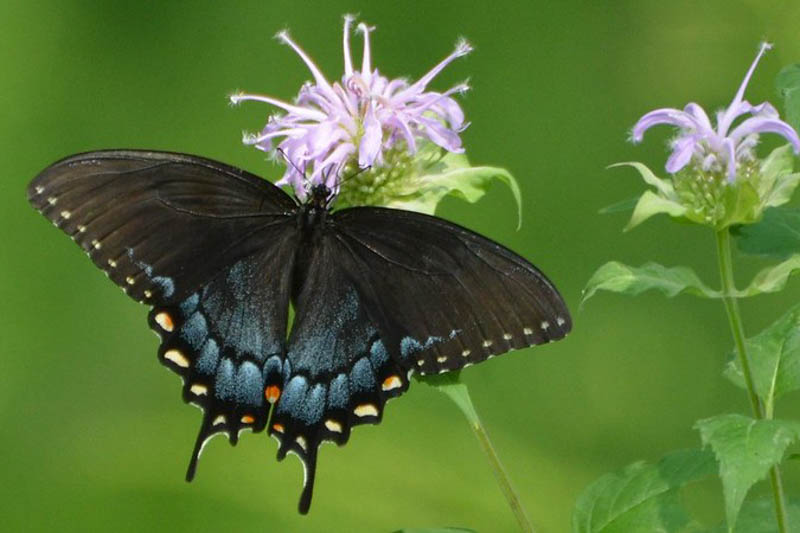
The Eastern Tiger Swallowtail butterfly does not migrate like other butterfly species, such as the Monarch butterfly. It overwinters in its chrysalid.
Flight Characteristics: The Eastern Tiger Swallowtail is known for its graceful and somewhat leisurely flight. It has a distinctive style of flying that involves a series of powerful wing flaps followed by glides, which gives it a floating appearance. This butterfly is adept at navigating various landscapes, from dense forests to open meadows and suburban gardens.
Like many butterfly species, Eastern Tiger Swallowtails face various predators throughout their lifecycle, from caterpillars to adult butterflies. These predators play a role in the natural ecosystem, keeping populations in balance. Here are some common predators of the Eastern Tiger Swallowtail:
Birds: Many bird species prey on butterflies, and the Eastern Tiger Swallowtail is no exception. Birds can catch adults in flight or while they are resting on flowers or basking. Bird predation is one of the reasons why the caterpillars have evolved to resemble bird droppings in their early stages and later, display eye spots to mimic the appearance of a predator.
Spiders: Spiders, especially orb weavers and crab spiders, are significant predators. They often capture butterflies in their webs or ambush them on flowers.
Wasps and Hornets: Certain species of wasps and hornets are known to hunt adult butterflies or caterpillars. They can be particularly aggressive predators, impacting butterfly populations.
Parasitic Flies and Wasps: Parasitic flies and wasps can lay their eggs on or inside caterpillars. The emerging larvae consume the caterpillar from the inside.
Mammals: Small mammals like rodents and shrews may eat caterpillars and chrysalises, especially those that are ground-dwelling or on low vegetation.
Amphibians and Reptiles: Frogs, toads, and lizards can also be predators, typically preying on caterpillars and sometimes adult butterflies.
The presence of these predators is a natural and essential part of the ecosystem, helping to maintain a balance in butterfly populations and contributing to the biodiversity of the habitat. The Eastern Tiger Swallowtail, through its various adaptive strategies like mimicry and camouflage, demonstrates nature’s intricate balance of predator and prey.
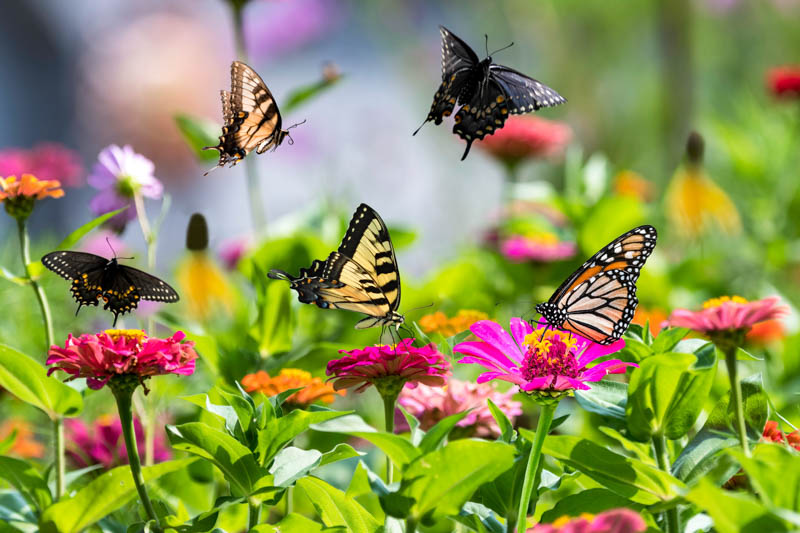
Attracting Eastern Tiger Swallowtail butterflies to your garden involves creating a habitat that caters to their specific needs. Here’s how to transform your space into a haven for these magnificent butterflies:
Plant Host Trees for Caterpillars: Incorporate host plants where females can lay eggs and caterpillars can feed. Preferred host plants include wild black cherry (Prunus serotina), tulip tree (Liriodendron tulipifera), sweet bay (Magnolia virginiana), ash (Fraxinus), hop tree (Ptelea trifoliata), cottonwood (Populus), basswood (Tilia), birch (Betula), mountain ash (Sorbus)and willow (Salix spp.). Remember, caterpillars are voracious eaters, so expect some leaf damage on these plants.
Provide Nectar-Rich Flowers: Adult Eastern Tiger Swallowtails feed on nectar. Include a variety of flowering plants that bloom at different times to ensure a continuous food source. Ideal nectar sources include butterfly bush (Buddleia), Joe-Pye Weed (Eutrochium purpureum), milkweed (Asclepias spp.), phlox (Phlox spp.), ironweed (Vernonia spp.), coneflower (Echinacea spp.), and lilac (Syringa spp.).
Create Sunny and Sheltered Spots: Butterflies need the sun to warm their bodies for flight. Ensure your garden has sunny areas, especially in the morning. Provide shelter from strong winds with hedges, tall plants, or garden structures.
Offer Water and Minerals: Create a “puddling” area where butterflies can sip on minerals and water. A shallow dish with moist sand or mud is perfect for this.
Avoid Pesticides: Chemicals can harm butterflies at all stages of their life cycle. Use organic pest control methods to keep your garden safe for them.
Encourage Overwintering: Eastern Tiger Swallowtails overwinter as chrysalises. Leave a few areas of your garden undisturbed and wild to provide them with safe overwintering sites.
Garden Maintenance: Regularly deadhead flowers to encourage more blooms. Be mindful of caterpillars and chrysalises when pruning.
By following these guidelines, you can create an attractive environment for Eastern Tiger Swallowtails, offering them a safe and nourishing space to feed, breed, and thrive. Your butterfly haven will not only support these beautiful creatures but also add color, life, and vibrancy to your garden.
Create a membership account to save your garden designs and to view them on any device.
Becoming a contributing member of Gardenia is easy and can be done in just a few minutes. If you provide us with your name, email address and the payment of a modest $25 annual membership fee, you will become a full member, enabling you to design and save up to 25 of your garden design ideas.
Join now and start creating your dream garden!
Create a membership account to save your garden designs and to view them on any device.
Becoming a contributing member of Gardenia is easy and can be done in just a few minutes. If you provide us with your name, email address and the payment of a modest $25 annual membership fee, you will become a full member, enabling you to design and save up to 25 of your garden design ideas.
Join now and start creating your dream garden!